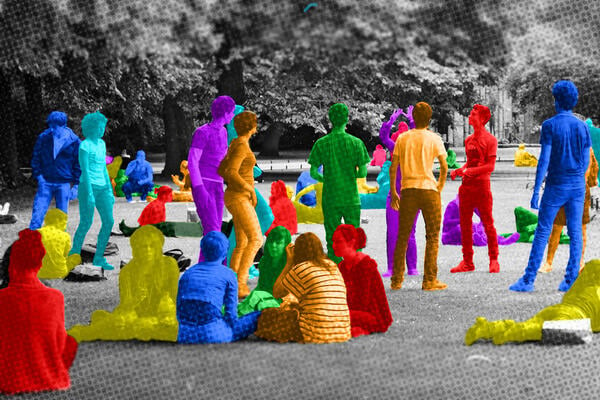
Fewer Colleges Publicized Racial Demographic Data This Year
Experts suggested that colleges might not want to attract attention to themselves right now with regard to issues of diversity.
Photo illustration by Justin Morrison/Inside Higher Ed | Liz Leyden/iStock/Getty Images
Last fall, a slew of highly selective institutions released incoming class data showing the impacts of the first admissions cycles since the Supreme Court banned affirmative action. The data varied wildly from institution to institution; many experienced precipitous drops in the percentage of Black and Hispanic students in their freshman classes, but others saw much slighter drops or even small increases.
But this year, institutions aren’t being as forthcoming about their data, according to James Murphy, director of career pathways and postsecondary policy at Education Reform Now, a nonprofit education think tank. Murphy tracked demographic data from 39 selective institutions last fall and planned to do the same this year, only to find that many institutions had yet to publicly release the information this semester. As of Oct. 16, Murphy had tracked down disaggregated race data on the incoming classes at 16 institutions, as compared to 34 on the same date in 2024.
“The fact that so many places have not shared data is unsurprising, understandable and still disappointing. It’s unsurprising because last year, some colleges got some probably unwanted attention” for declines in the enrollment of Hispanic and Black students, Murphy said.
In the year since admissions demographic data drove headlines, Donald Trump returned to the White House and has cracked down on a wide range of race-based programs and activities. Using an expansive interpretation of the 2023 Supreme Court ruling in Students for Fair Admissions v. Harvard, his administration has ramped up the scrutiny on admissions practices and opened a number of investigations, accusing universities of failing to fully comply with the court’s order. More recently, Trump officials have asked colleges to give feedback on a wide-ranging compact for higher ed that would require, among other things, that universities ban consideration of race in hiring and admissions processes.
The administration also has proposed a new requirement for institutions to submit expanded data on the racial demographics of the students who applied, were admitted and enrolled at their institutions. The administration has said that its goal is to ensure colleges are not skirting the SFFA ruling. Critics say they fear that the administration will use the data to penalize colleges it feels do not admit enough white students.
Inside Higher Ed reached out to the institutions that haven’t publicly released demographic data on their incoming classes for more information about why. Some institutions did not provide a reason for the delay but said that they are planning to release demographic data soon. Brown University, which reached an agreement with the Trump administration earlier this year that included the disclosure of certain admissions data, said it is waiting to publish racial demographic data until it submits that data to the federal government.
“Given the requirement that we report admissions data to the federal government per the terms of Brown’s July 30 resolution agreement, we will release admissions and enrollment data on a single timeline to ensure consistency in the information across all internal and external sources. No additional data is available at this time,” spokesman Brian E. Clark wrote in an email.
The lack of public data may also indicate a decreased lack of interest in the data from the media and the public; a spokesperson for Williams College said the college doesn’t typically post disaggregated data publicly until data from the Integrated Postsecondary Education Data System goes live, but it will provide it upon request. Last year, the student paper published the institution’s figures but didn’t do the same this year.
Other colleges more overtly removed disaggregated data from their fall enrollment announcements. In its news release last year, published on Sept. 12, 2024, Pomona College highlighted changes in the incoming class’s racial makeup as compared to the previous year, noting a sharp decrease in the percentage of Black students and an increase in the number of students who did not include their race. Pomona’s 2025 announcement, released exactly a year later, only included a total percentage of students who are people of color.
The college declined to comment on the change.
“I think most colleges are probably trying to lay low and just not attract any attention to themselves for anything related to issues of race and diversity, unfortunately, given the current political climate,” said Julie J. Park, a professor of education at the University of Maryland and the author of a forthcoming book about post–affirmative action college admissions.
This data will eventually become public, as colleges and universities are required to submit enrollment data disaggregated by race to the federal government via IPEDS.
Limited Data
It’s hard to extrapolate much from the 16 colleges whose data is represented in Murphy’s tracker—and, as was the case last year, it’s still too early to draw definitive conclusions about how the Supreme Court’s decision affected enrollment.
Still, Murphy noted that at 14 out of the 16 institutions, Black students comprised a smaller share of the incoming classes in the past two freshman classes compared to the previous two.
“It’s important to be careful about making conclusions based on both two years of data and a really small sample set … Black enrollment was the one demographic where there was just no way around it. It dropped at almost every single school,” he said.
Park also noted that there are other major factors that could influence this fall’s admissions data. For some institutions, for example, it was their first year bringing back standardized test requirements after several years of test-optional policies.
It’s also impossible to know which demographic changes are linked directly to the affirmative action ruling or related to the Trump administration’s crusade against the consideration of race in admissions.
“A lot of the executive orders came out in January 2025, so that’s early enough to have potentially contributed to this climate of fear or concern in admissions offices,” she said. “But until, I think, we have a few more years, it’ll be hard to know.”
Source link


